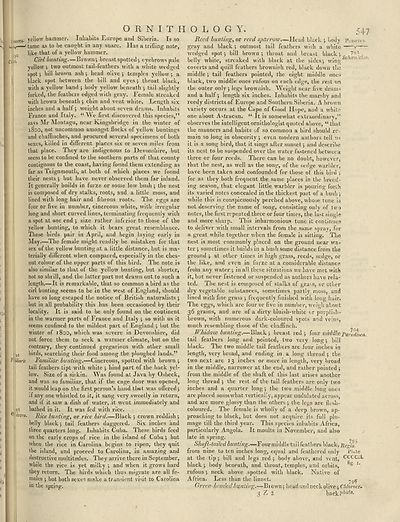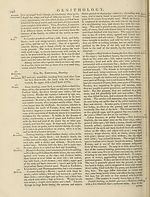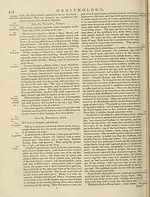Encyclopaedia Britannica > Volume 15, NIC-PAR
(601) Page 547
Download files
Complete book:
Individual page:
Thumbnail gallery: Grid view | List view

ORNITHOLOGY.
;ercg, yellow hammer. Inhabits Europe and Siberia. Is so
' tame as to be caught in any snare. Has a trifling note,
like that of a yellow hammer.
Cirl bunting.—Brown; breast spotted; eyebrows pale
yellow ; two outmost tail-feathers with a white wedged
spot; bill brown ash; head olive ; temples yellow ; a
black spot between the bill and eyes; throat black,
with a yellow band ; body yellow beneath ; tail slightly
forked, the feathers edged with gray. Female streaked
with brown beneath ; chin and vent white. Length six
inches and a half; weight about seven drams. Inhabits
France and Italy. “We first discovered this species,”
says Mr Montagu, near Kingsbridge in the winter of
1800, not uncommon amongst flocks of yellow buntings
and chaffinches, and procured several specimens of both
sexes, killed in difterent places six or seven miles from
that place. They are indigenous to Devonshire, but
seem to be confined to the southern parts of that county
contiguous to the coast, having found them extending as
far as Teignmouth, at both of which places we found
their nests ; but have never observed them far inland.
It generally builds in furze or some low bush ; the nest
is composed of dry stalks, roots, and a little moss, and
lined with long hair and fibrous roots. The eggs are
four or five in number, cinereous white, with irregular
long and short curved lines, terminating frequently with
a spot at one end ; size rather inferior to those of the
yellow bunting, to which it bears great resemblance.
These birds pair in April, and begin laying early in
May.—The female might readily be mistaken for that
sex of the yellow bunting at a little distance, but is ma¬
terially different when compared, especially in the ches-
nut colour of the upper parts of this bird. The note is
also similar to that of the yellow bunting, but shorter,
not so shrill, and the latter part not drawn out to such a
length.—It is remarkable, that so common a bird as the
cirl bunting seems to be in the west of England, should
have so long escaped the notice of British naturalists ;
but in all probability this has been occasioned by their
locality. It is said to he only found on the continent
in the warmer parts of France and Italy ; so with us it
seems confined to the mildest part of England ; but the
winter of 1800, which was severe in Devonshire, did
not force them to seek a warmer climate, but on the
contrary, they continued gregarious with other small
9I birds, searching their food among the ploughed lands.”
Maris Familiar bunting.—Cinereous, spotted with brown ;
tail feathers tipt with white ; hind part of the hack yel¬
low. Size of a siskin. Was found at Java by Osbeck,
and was so familiar, that if the cage door was opened,
it would leap on the first person’s hand that was ofl’ered;
if any one whistled to it, it sang very sweetly in return,
and if it saw a dish of water, it went immediately and
02 bathed in it. It was fed with rice.
tvora. Jlice bunting, or rice bird.—Black ; crown reddish ;
belly black; tail feathers daggered. Six inches and
three quarters long. Inhabits Cuba. These birds feed
on the early crops of rice in the island of Cuba ; but
when the rice in Carolina begins to ripen, they quit
the island, and proceed to Carolina, in amazing and
destructive multitudes. They arrive there in September,
while the rice is yet milky ; and when it grows hard
they return. The birds which thus migrate are all fe¬
males ; hut both sexes make a transient visit to Carolina
in the spring.
Reed bunting, or reed sparrow,—Head black ; body Passen s
gray and black ; outmost tail feathers with a white v——
wedged spot; bill brown; throat and breast black; „ 7°! 7
belly white, streaked with black at the sides; wing
coverts and quill feathers brownish red, black down the
middle; tail feathers pointed, the eight middle ones
black, two middle ones rufous on each edge, the rest on
the outer only; legs brownish. Weight near five drams
and a half; length six inches. Inhabits the marshy ami
reedy districts of Europe and Southern Siberia. A brown
variety occurs at the Cape of Good Hope, and a white
one about Astracan. “ It is somewhat extraordinary,”
observes the intelligent ornithologist quoted above, “ that
the manners and habits of so common a bird should re¬
main so long in obscurity; even modern authors tell ns
it is a song bird, that it sings after sunset; and describe
its nest to be suspended over the water fastened between
three or four reeds. There can he no doubt, however,
that the nest, as well as the song, of the sedge warbler,
have been taken and confounded for those of this bird ;
for as they both frequent the same places in the breed¬
ing season, that elegant little warbler is pouring forth
its varied notes concealed in the thickest part of a bus!);
while this is conspicuously perched above, whose tune is
not deserving the name of song, consisting only of two
notes, the first repeated three or four times, the last single
and more sharp. This inharmonious tune it continues
to deliver with small intervals from the same sprav, for
a great while together when the female is sitting. The
nest is most commonly placed on the ground near wa¬
ter ; sometimes it builds in a bush some distance from the
ground ; at other times in high grass, reeds, sedge, or
the like, and even in furze at a considerable distance
from any water ; in all these situations we have met with
it, but never fastened or suspended as authors have rela¬
ted. The nest is composed of stalks of grass, or other
dry vegetable substances, sometimes partly moss, and
lined with fine grass ; frequently finished with long hair.
The eggs, which are four or five in number, weigh about
36 grains, and are of a dirty bluish-white or purplish-
brown, with numerous dark-coloured spots and veins,
much resembling those of the chaffinch.
JFhi da w bunting.—Black; breast red ; four middle Paradisca.
tail feathers long and pointed, two very long; bill
black. The two middle tail feathers are four inches in
length, very broad, and ending in a long thread ; the
two next are 13 inches or more in length, very broad
in the middle, narrower at the end, and rather pointed ;
from the middle of the shaft of this last arises another
long thread ; the rest of the tail feathers are only two
inches and a quarter long ; the two middle long ones
are placed somewhat vertically, appear undulated across,
and are more glossy than the others ; the legs are flesh-
coloured. The female is wholly of a deep brown, ap¬
proaching to black, but does not acquire its full plu¬
mage till the third year. This species inhabits Africa,
particularly Angola. It moults in November, and also
late in spring.
Shaft-tailed iwwfrwg.—Four middle tail feathers black, Regia.
from nine to ten inches long, equal and feathered only iJJutc
at the tip ; bill and legs red ; body above, and vent, CCCCII.
black ; body beneath, and throat, temples, and orbits, (l®' I*
rufous ; neck above spotted with black. Native of
Africa. Less than the linnet.
Greenheaded bunting.—Brown; head and neck olive; Chlordct-
3 Z 2 back^^
;ercg, yellow hammer. Inhabits Europe and Siberia. Is so
' tame as to be caught in any snare. Has a trifling note,
like that of a yellow hammer.
Cirl bunting.—Brown; breast spotted; eyebrows pale
yellow ; two outmost tail-feathers with a white wedged
spot; bill brown ash; head olive ; temples yellow ; a
black spot between the bill and eyes; throat black,
with a yellow band ; body yellow beneath ; tail slightly
forked, the feathers edged with gray. Female streaked
with brown beneath ; chin and vent white. Length six
inches and a half; weight about seven drams. Inhabits
France and Italy. “We first discovered this species,”
says Mr Montagu, near Kingsbridge in the winter of
1800, not uncommon amongst flocks of yellow buntings
and chaffinches, and procured several specimens of both
sexes, killed in difterent places six or seven miles from
that place. They are indigenous to Devonshire, but
seem to be confined to the southern parts of that county
contiguous to the coast, having found them extending as
far as Teignmouth, at both of which places we found
their nests ; but have never observed them far inland.
It generally builds in furze or some low bush ; the nest
is composed of dry stalks, roots, and a little moss, and
lined with long hair and fibrous roots. The eggs are
four or five in number, cinereous white, with irregular
long and short curved lines, terminating frequently with
a spot at one end ; size rather inferior to those of the
yellow bunting, to which it bears great resemblance.
These birds pair in April, and begin laying early in
May.—The female might readily be mistaken for that
sex of the yellow bunting at a little distance, but is ma¬
terially different when compared, especially in the ches-
nut colour of the upper parts of this bird. The note is
also similar to that of the yellow bunting, but shorter,
not so shrill, and the latter part not drawn out to such a
length.—It is remarkable, that so common a bird as the
cirl bunting seems to be in the west of England, should
have so long escaped the notice of British naturalists ;
but in all probability this has been occasioned by their
locality. It is said to he only found on the continent
in the warmer parts of France and Italy ; so with us it
seems confined to the mildest part of England ; but the
winter of 1800, which was severe in Devonshire, did
not force them to seek a warmer climate, but on the
contrary, they continued gregarious with other small
9I birds, searching their food among the ploughed lands.”
Maris Familiar bunting.—Cinereous, spotted with brown ;
tail feathers tipt with white ; hind part of the hack yel¬
low. Size of a siskin. Was found at Java by Osbeck,
and was so familiar, that if the cage door was opened,
it would leap on the first person’s hand that was ofl’ered;
if any one whistled to it, it sang very sweetly in return,
and if it saw a dish of water, it went immediately and
02 bathed in it. It was fed with rice.
tvora. Jlice bunting, or rice bird.—Black ; crown reddish ;
belly black; tail feathers daggered. Six inches and
three quarters long. Inhabits Cuba. These birds feed
on the early crops of rice in the island of Cuba ; but
when the rice in Carolina begins to ripen, they quit
the island, and proceed to Carolina, in amazing and
destructive multitudes. They arrive there in September,
while the rice is yet milky ; and when it grows hard
they return. The birds which thus migrate are all fe¬
males ; hut both sexes make a transient visit to Carolina
in the spring.
Reed bunting, or reed sparrow,—Head black ; body Passen s
gray and black ; outmost tail feathers with a white v——
wedged spot; bill brown; throat and breast black; „ 7°! 7
belly white, streaked with black at the sides; wing
coverts and quill feathers brownish red, black down the
middle; tail feathers pointed, the eight middle ones
black, two middle ones rufous on each edge, the rest on
the outer only; legs brownish. Weight near five drams
and a half; length six inches. Inhabits the marshy ami
reedy districts of Europe and Southern Siberia. A brown
variety occurs at the Cape of Good Hope, and a white
one about Astracan. “ It is somewhat extraordinary,”
observes the intelligent ornithologist quoted above, “ that
the manners and habits of so common a bird should re¬
main so long in obscurity; even modern authors tell ns
it is a song bird, that it sings after sunset; and describe
its nest to be suspended over the water fastened between
three or four reeds. There can he no doubt, however,
that the nest, as well as the song, of the sedge warbler,
have been taken and confounded for those of this bird ;
for as they both frequent the same places in the breed¬
ing season, that elegant little warbler is pouring forth
its varied notes concealed in the thickest part of a bus!);
while this is conspicuously perched above, whose tune is
not deserving the name of song, consisting only of two
notes, the first repeated three or four times, the last single
and more sharp. This inharmonious tune it continues
to deliver with small intervals from the same sprav, for
a great while together when the female is sitting. The
nest is most commonly placed on the ground near wa¬
ter ; sometimes it builds in a bush some distance from the
ground ; at other times in high grass, reeds, sedge, or
the like, and even in furze at a considerable distance
from any water ; in all these situations we have met with
it, but never fastened or suspended as authors have rela¬
ted. The nest is composed of stalks of grass, or other
dry vegetable substances, sometimes partly moss, and
lined with fine grass ; frequently finished with long hair.
The eggs, which are four or five in number, weigh about
36 grains, and are of a dirty bluish-white or purplish-
brown, with numerous dark-coloured spots and veins,
much resembling those of the chaffinch.
JFhi da w bunting.—Black; breast red ; four middle Paradisca.
tail feathers long and pointed, two very long; bill
black. The two middle tail feathers are four inches in
length, very broad, and ending in a long thread ; the
two next are 13 inches or more in length, very broad
in the middle, narrower at the end, and rather pointed ;
from the middle of the shaft of this last arises another
long thread ; the rest of the tail feathers are only two
inches and a quarter long ; the two middle long ones
are placed somewhat vertically, appear undulated across,
and are more glossy than the others ; the legs are flesh-
coloured. The female is wholly of a deep brown, ap¬
proaching to black, but does not acquire its full plu¬
mage till the third year. This species inhabits Africa,
particularly Angola. It moults in November, and also
late in spring.
Shaft-tailed iwwfrwg.—Four middle tail feathers black, Regia.
from nine to ten inches long, equal and feathered only iJJutc
at the tip ; bill and legs red ; body above, and vent, CCCCII.
black ; body beneath, and throat, temples, and orbits, (l®' I*
rufous ; neck above spotted with black. Native of
Africa. Less than the linnet.
Greenheaded bunting.—Brown; head and neck olive; Chlordct-
3 Z 2 back^^
Set display mode to:
![]() Universal Viewer |
Universal Viewer | ![]() Mirador |
Large image | Transcription
Mirador |
Large image | Transcription
Images and transcriptions on this page, including medium image downloads, may be used under the Creative Commons Attribution 4.0 International Licence unless otherwise stated. ![]()
| Encyclopaedia Britannica > Encyclopaedia Britannica > Volume 15, NIC-PAR > (601) Page 547 |
|---|
| Permanent URL | https://digital.nls.uk/192589511 |
|---|
| Attribution and copyright: |
|
|---|
| Shelfmark | EB.11 |
|---|---|
| Description | Ten editions of 'Encyclopaedia Britannica', issued from 1768-1903, in 231 volumes. Originally issued in 100 weekly parts (3 volumes) between 1768 and 1771 by publishers: Colin Macfarquhar and Andrew Bell (Edinburgh); editor: William Smellie: engraver: Andrew Bell. Expanded editions in the 19th century featured more volumes and contributions from leading experts in their fields. Managed and published in Edinburgh up to the 9th edition (25 volumes, from 1875-1889); the 10th edition (1902-1903) re-issued the 9th edition, with 11 supplementary volumes. |
|---|---|
| Additional NLS resources: |
|

